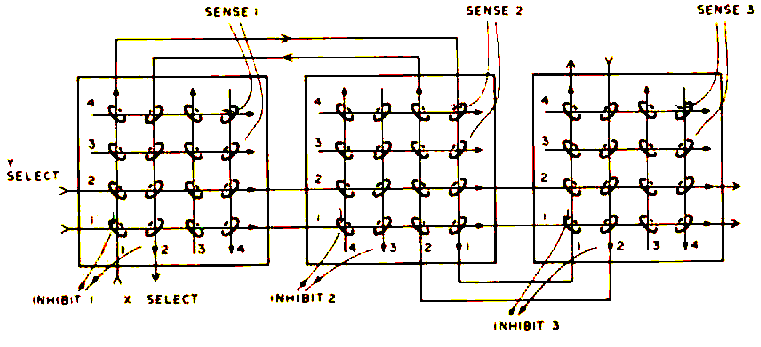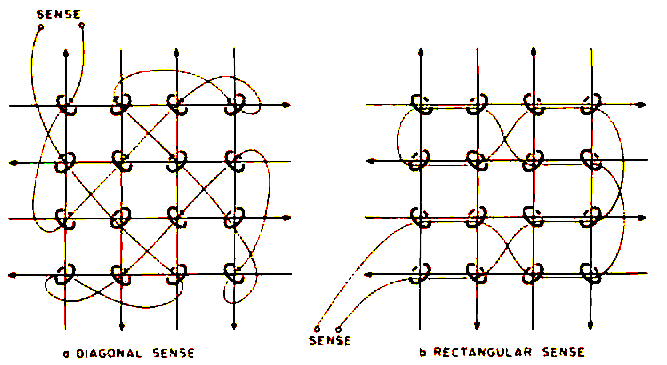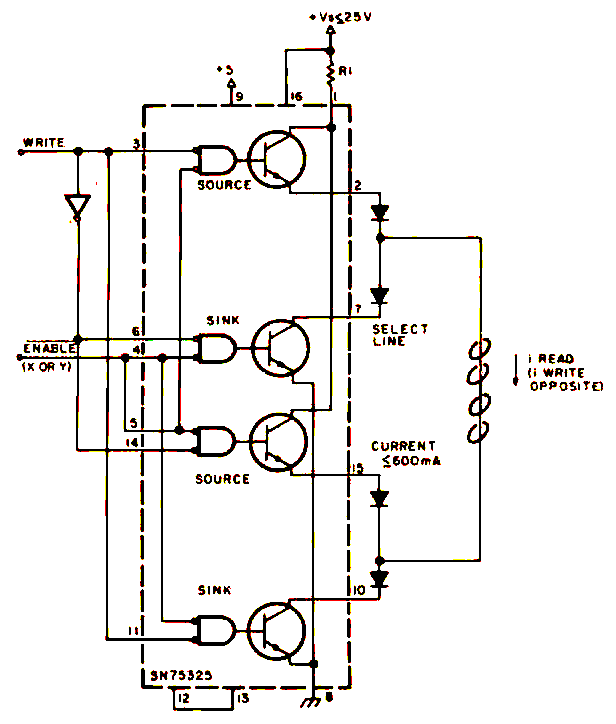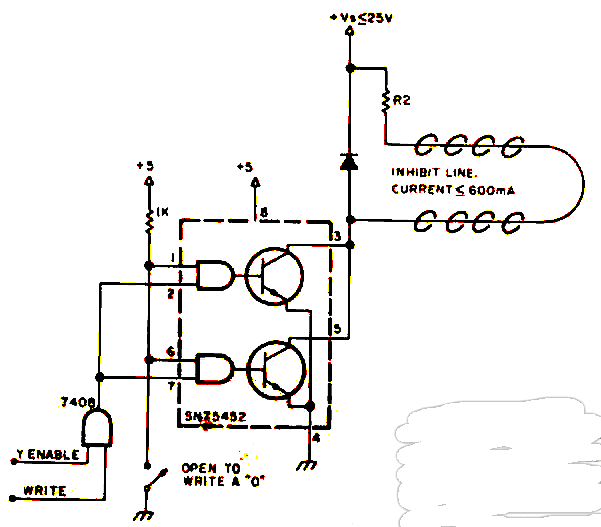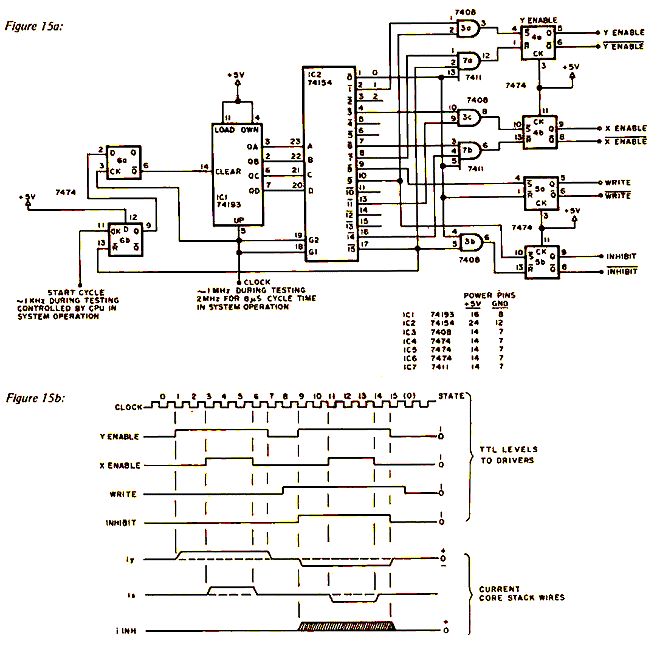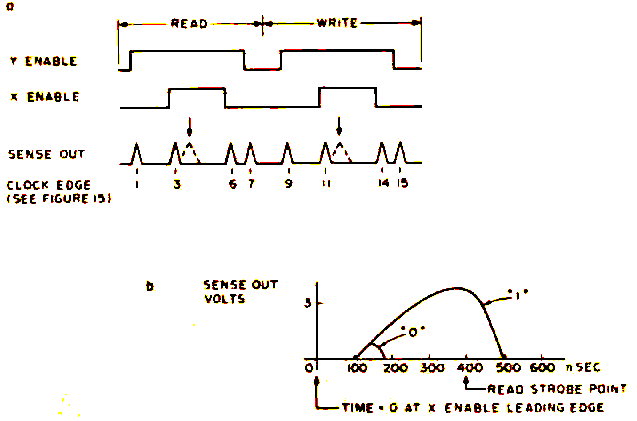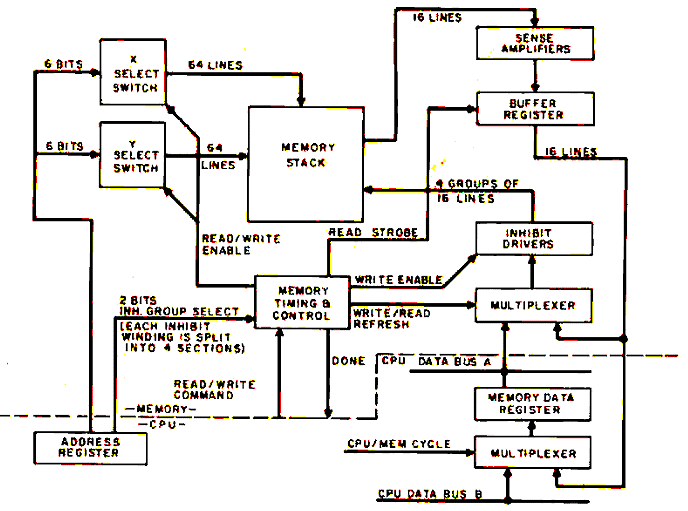
| Figure l: For a wire carrying current i directed our of the page, the magnetic field H is proportional to i/r. The direction of H is tangential to the circle of radius r, as shown for points P1, P2 and P3. |
Coincident Current
Ferrite Core Memories
James R Jones
111 E Jefferson
Colorado Spring CO 80807
Have you ever looked through the surplus catalogs arid wondered whether those memory core planes and stacks advertised could be used for anything other than tea strainers? How are they supposed to work, and what kind of circuitry is required? Could you troubleshoot and repair that surplus core memory and drive electronics? What good is a core stack without data? Is it a worthwhile project to build a memory system around a core stack?
Some of these questions ran be answered directly in what follows. Others can be answered at least partially in terms of my own experience: getting one surplus core stack to work as the main memory of my home brew computer by building the necessary electronics without the benefit of manufacturer's data.
Perhaps the biggest advantage of the core memory over other types of random access memories is its ability to retain stored data when power is removed, and to have it readily available when power is restored. This feature is sometimes used by minicomputer manufacturers to ship their products with preloaded systems software. Also, for some forms of core memory, the storage capacity increases much faster than the amount of driving electronics. In order to understand the functional requirements and the operating restrictions placed on core memory driving circuitry, it is necessary to take a close look at how cores work, and how they are typically organized to form large capacity stacks.
Magnetic Fields and Hysteresis
The memory storage element is the ferrite core itself. Its function is to accept, store, and
read out a bit of information. It can do this by virtue of its ferromagnetic properties. These
allow it to be easily, but strongly, magnetized in a preferred direction by an
externally applied
magnetic field to signify a 1 bit value, to be easily magnetized in another direction
to signify
a 0 bit value, and to retain its magnetic direction when the external field is removed.
Physically the core is a small doughnut shaped object made of pressed, heat treated, nonconductive, iron oxide powder. A typical dimension Is 0.02 to 0.2 inches in diameter (0.5 to 5 mm). The external magnetic fields are applied to the core by means of wires passing through it carrying controlled amounts of current.
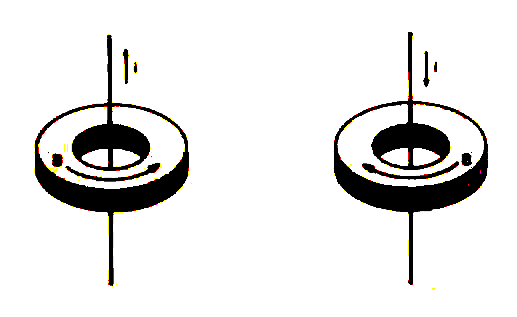
| Figure 2: The direction of magnetic induction B in the core results from alignment of c structures with the magnetic field due to current i. |
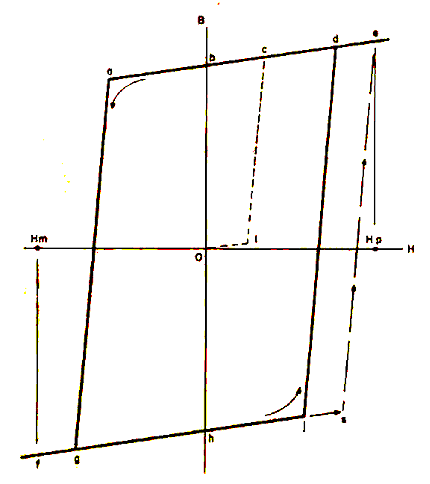
| Figure 3: Memory properties are derived from the hysteresis properties of the core material. When the applied H value is 0, the residual B value in the core material will depend upon the past history o! magnetization. This figure and subsequent figures show the magnitude of the vector quantities H and B, with positive and negative solves corresponding to the two directions of rotation about the core axis. |
Because of the geometry of the cores with respect to the wire, it is possible for us to drop the vector notation and simply refer to the magnitude of B and H in the discussion which follows. The exact way the strength of Bin the core depends on the strength of applied field H (proportional to current I) is represented graphically in the scalar B versus H curve of figure 3.
After manufacture, the core has no magnetization, and B = 0. If applied field H is increased from 0 to Hp, B increases along path 0-1-c-e. If H decreases to 0, B decreases from e to b, leaving the core magnetized with no applied field present. Decreasing H from 0 to Hm causes B to move along b-a-g-f, changing direction as a passes through 0. As H increases to 0, B moves to h, again leaving the core magnetized with no applied field, but in a direction opposite that above. As H increases again from 0 to Hp. B moves along h-j-d-e.. If H is again varied as described above, B will trace the same counter clockwise path.
This effect of tracing two alternate paths between two flied states, instead of tracing a single path, is called hysteresis, In the core, this is due to the alignment of the magnetic domains, a process which requires a minimum applied field to force alignment in a given direction. When the applied field is removed, the aligned structures provide the core with its own field. Path segments a to g and j to d, where this effect occurs, are termed irreversible. Reversible magnetic effects also occur in the core. For example, if B is at position h, H can be varied to move B back and forth along line f-j as many times as desired as long as B is not increased past point j. Variations along line a-e are also reversible to point a. This effect is due to elastic deformation of the microscopic structures and alignment of molecular structures, both of which return to normal when the applied field is removed. Both effects are important: Hysteresis is the memory property; reversibility, although the largest noise contributor in the core, allows the core to act as an AND gate, a key principle in selection of individual bits.

| Figure 4: Sense voltages perceived on a wire .strung though the core depend upon the previous B magnetization state in the core as a current pulse is passed through the wire. A non-switching core produces a simple transient due to reversible B field changes induced in the core by the current edges as at (a). When the core switches as at (b), an extra transient pulse is induced in the sense wire. |
Sensing Core Magnetism Changes
Using the Core to Remember
Memories Larger Than One Bit
Coincidence Current Selection
Property and Operation Restrictions
Reading and Writing Words: The 3D Memory
Sending half select currents through X1
and Y1 select lines in the arrow directions will
cause the core at (1 ,1) in each array to read
out via the associated array sense line.
Reversing the select current directions will
Changes in the core B field are sensed by
means of a second wire passed through the
core. The voltage difference appearing at the
ends of the sense wire is proportional to the
change in B, and inversely proportional to the
time required for the change. So that an
irreversible change can produce a large signal.
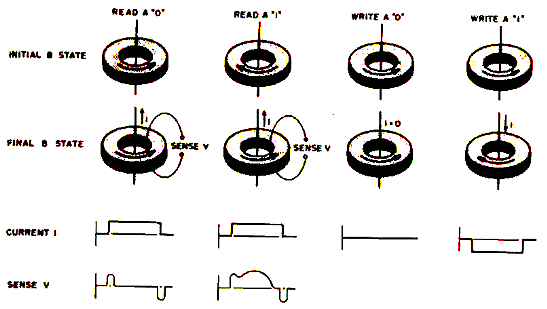
Figure 5: Using the physics of core switching. This figure
shows the four basic operations needed to
manipulate the binary state of a core:
Read a "0", read a "1", write a "0", write a "1".
If we now interpret the initial direction of a
in the cores to represent a stored 0
(figure 4a) or a stored 1 (figure 4b), and read the
core contents by the method of figure 4, then
read and write operations can be performed a
indicated in figure 5. Two things should be
noted: First, a stored 1 is destroyed In the process
of reading it because the core is reset to the
0 state. If it is necessary to retain the 1 in
memory for later use, a special refresh write
operation is required to restore the 1. Second,
the cases of writing into a core already
containing a 1 is not shown, because the
memory control logic is usually designed such
that a destructive read cycle always occurs
before the write cycle, for a given core.
Using the method of figure 5 can be an
expensive undertaking if one wants to store
4096 bits, for instance. Although the sense
line can be made to pass through all the cores
to detect switching of a selected care, circuitry
must be built which can select any one of 4096
cores and supply the proper read or write
current to it alone. To reduce the amount of
selection circuitry required
for large memories, the cores' reversibility
property is used to assist in the selection
process, This is done by passing two
independently controlled current lines instead of
just one through a given core; each line can
pass half the current of the original line. Due to
the shape of the B versus H curve, if only one
line passes half the required switching current
required, B remains in the reversible region and
returns to the original state (figure 6a) when
the current is removed. If both lines pass
current, core switching occurs if the core is in
the proper original state (figure 6b and c).
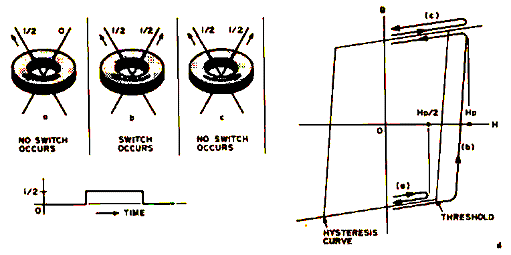
Figure 6: How hysteresis makes coincident current bit selection possible.
The principle involved is
simple: A current of i is sufficient to generate an H field strength which
will drive the core from one store to the opposite state,
but a current of i/2 is insufficient to cause the core to cross the
threshold of the hysteresis curve. The H field of two separate wires add,.
that if two wires carry currents of i/2 in the same direction,
the result is the some as a single wire carrying a current of i.
The hysteresis curve at the right (d) shows the paths taken by the B field
in the case of a single i/2 current (a), additive i/2 currents forcing a change (b),
and additive. i/2 currents causing to change
since the core is already in a state aligned with the H field (c).
Thus by the means of coincident currents,
the core acts as an AND gate; both currents
need to be present simultaneously
to choose the core and allow it to switch
if it is in the proper state. A multiple bit
memory can now be constructed as shown in
figure 7.
If currents are applied to lines X2 and Y3, the
core at (2,3) is selected. Other cores on the lines
X2 and Y3 are half selected. Only
one pair of lines is allowed to carry current at
any one time. To read the core contents
at (2,3), current is passed as indicated. To
now write a 1, the current is reversed; to write
a 0, no current is applied.
Arrangement of cores in the coincidence
current mode imposes so rather severe
requirements on core fabrication and memory
operating conditions. For a core in B state x in
figure 8, the half select current must generate
a field less than Hk to prevent B from passing
the "knee" of the curve. But the tool select
current must generate a field greater than Hs
to ensure full switching of the core. Thus the
half select current can only produce fields in
the range shown by the heavy line. As the
quantity (Hs - Hk) gets smaller, the operating
range gets larger. So the cores are made with
(Hs - Hk) as small as possible, but even if it
were zero, the half select current would have;
maximum tolerance of 33% of its midrange
value. The operating range is further restricted
by two more factors. First, manufacturing and
assembly tolerances allow memories to be
constructed of cores with slightly differing B
versus H curves, effectively increasing the
difference (Hs - Hk) as all cores are
considered. Second, as the memory is
operated, the cores heat up due to switching
losses, select line heat, and heat from nearby
electronics, causing the entire B versus H curve
to shrink towards the origin. Newer core
memories me made using ferrite with low
temperature sensitivity; but this is not true of
older memories, and such measures as
constant temperature ovens, forced air cooling,
and power supply temperature compensation
have been used to ensure reliable operation. ,
The coincidence current scheme certainly
cuts down the required selection circuitry,
although at the expense of operating
tolerances. The 20 cores of figure 7 are
selected by nine lines, and the 4096 bit
memory mentioned earlier, if arranged in a 64
X 64 array, has only 128 select lines. Further
economy is realized if the idea is expanded to
word organized memories. For example,
consider the 16 bit array of figure 9 which has
an added winding - the inhibit line (the arrows on
the select lines indicate the read current
directions). If a 16 word memory of 3 bits per
word is desired, three of these bit planes are
interconnected as shown in figure 10.
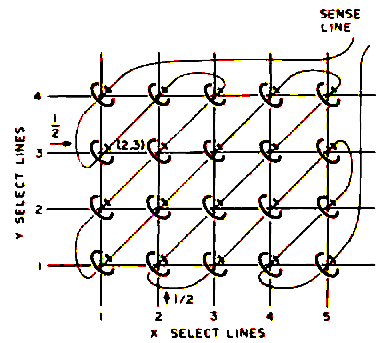
Figure 7: The concept of a coincident current selection is implemented
using an array of cores with X and Y lines. in this example, a total of 20 cores is
wired with a single sense wire, 4 Y selection wires and 5 X selection wires.
When i/2 (see figure 6) is flowing through one X and one Y line, the matrix
intersection point is addressed. In this example, the care et (2,3) will either be read
or written. Actual core arrays are much larger than this simple conceptual
illustration.
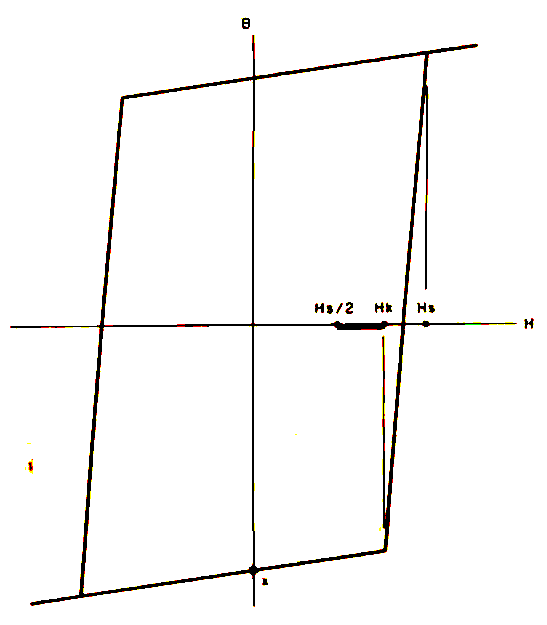
Figure 8: The half-select current i/2 must generate an H field less than
Hk if a change of state is to be avoided. Similarly, the full select current of i
must generate an H field strength greater than Hs to ensure switching. This
leaves a range of field strengths (and corresponding current values) from Hs/2 to
Hk which introduces a critical tolerance for the select currents in a core memory
design.
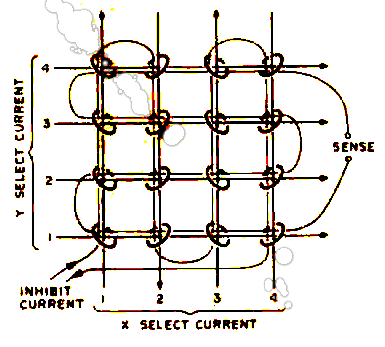
Figure 9: The inhibit line
is added to the array
assembly of cores so that it
possible to avoid
changing the state of a given core
with coincident current selection.
